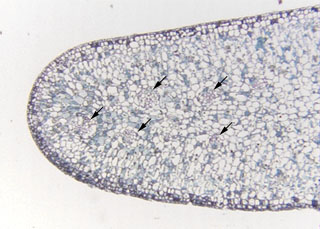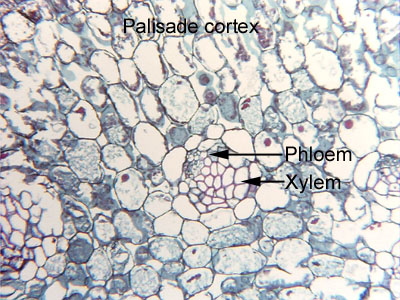 Fig.
11.3-6. Transverse section of cactus stem (Calymmanthium
substerile; from Peru, no common name). Many cacti have a thick cortex that
grows outward as ribs; in this species, the ribs are thin (only a few
millimeters) and project out from the main body several centimeters so in
transverse section they look like thick leaves. The upper micrograph is a
transverse section through the outermost part of one rib; the base of the rib
and the center of the stem are to the right, out of the image. In a very low
power view, this portion of a rib would look like just one arm of a star-shaped
stem.
Fig.
11.3-6. Transverse section of cactus stem (Calymmanthium
substerile; from Peru, no common name). Many cacti have a thick cortex that
grows outward as ribs; in this species, the ribs are thin (only a few
millimeters) and project out from the main body several centimeters so in
transverse section they look like thick leaves. The upper micrograph is a
transverse section through the outermost part of one rib; the base of the rib
and the center of the stem are to the right, out of the image. In a very low
power view, this portion of a rib would look like just one arm of a star-shaped
stem.
The outermost cortex cells of cacti are
aligned in rows, in a pattern that is similar to the palisade parenchyma of a
leaf (so they are called palisade cortex; not easy to see in the upper
micrograph, but is a little more obvious in the micrograph below). There is a set of cortical bundles that vascularizes the thick cortex,
including the rib. The system of cortical bundles looks quite a bit
like the veins of a leaf, and each bundle is collateral, having both xylem and
phloem. At the low magnification of the upper micrograph, each cortical bundle
is too small to be seen, but several are indicated by arrows.
There
has been research on this since the textbook was published; if you are
interested, you can read these papers:
Sajeva,
M, and J. D. Mauseth. 1991. Leaf-like structure in the photosynthetic, succulent
stems of cacti. Annals of Botany 68: 405-411.
Mauseth,
J. D., and M. Sajeva. 1992. Cortical bundles in the persistent, photosynthetic
stems of cacti. Annals of Botany 70: 317-324.